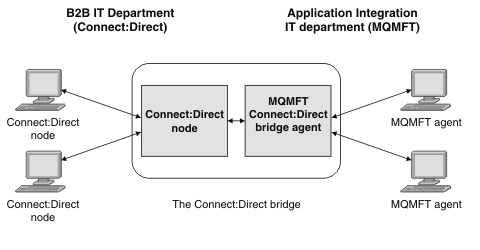The Connect:Direct bridge
You can transfer files to and from an existing IBM® Sterling Connect:Direct® network. Use the Connect:Direct bridge, which is a component of IBM MQ Managed File Transfer, to transfer files between MQMFT and IBM Sterling Connect:Direct.

Using the MQMFT Connect:Direct bridge, the two departments can transfer files between the Connect:Direct network in the B2B IT department and the MQMFT network in the Application Integration IT department. The Connect:Direct bridge is a component of IBM MQ Managed File Transfer, which includes an MQMFT agent that communicates with a Connect:Direct node. The MQMFT agent is dedicated to transfers with the Connect:Direct node, and is known as the Connect:Direct bridge agent.
- Use Managed File Transfer commands to initiate a transfer of a file, or multiple files, from an MQMFT agent to a Connect:Direct node.
- Use Managed File Transfer commands to initiate a transfer of a file, or multiple files, from a Connect:Direct node to an MQMFT agent.
- Use Managed File Transfer commands to initiate a file transfer that starts a user-defined Connect:Direct process.
- Use Connect:Direct process to submit an MQMFT file transfer request.
You can use the Connect:Direct bridge to transfer to or from a data set that is located on a Connect:Direct node on a z/OS® system. There are some differences in behavior compared to data set transfers that only involve IBM MQ Managed File Transfer agents. For more information, see Transferring data sets to and from Connect:Direct nodes.
Supported platforms
The Connect:Direct bridge is made up of an MQMFT Connect:Direct bridge agent and a Connect:Direct node. The agent is supported on Windows and Linux® for System x. The node is supported on the platforms that are supported for IBM Sterling Connect:Direct for Windows and IBM Sterling Connect:Direct for UNIX. For instructions on creating the Connect:Direct bridge agent and configuring a Connect:Direct node for the agent to communicate with, see Configuring the Connect:Direct bridge.
The Connect:Direct bridge can transfer files to and from Connect:Direct nodes that are running as part of a Connect:Direct for Windows or Connect:Direct for UNIX , or Connect:Direct for z/OS Service installation. For details of the versions of Connect:Direct that are supported, see the web page WebSphere MQ System Requirements.
- The agent and node are on the same system, which is either running Windows or Linux for System x
- The agent is on Linux for System x, and the node is on UNIX
- The agent is on one Windows system, and the node is on another Windows system
- The agent is on Linux for System x, and the node is on Windows
- The agent is on Windows, and the node is on UNIX